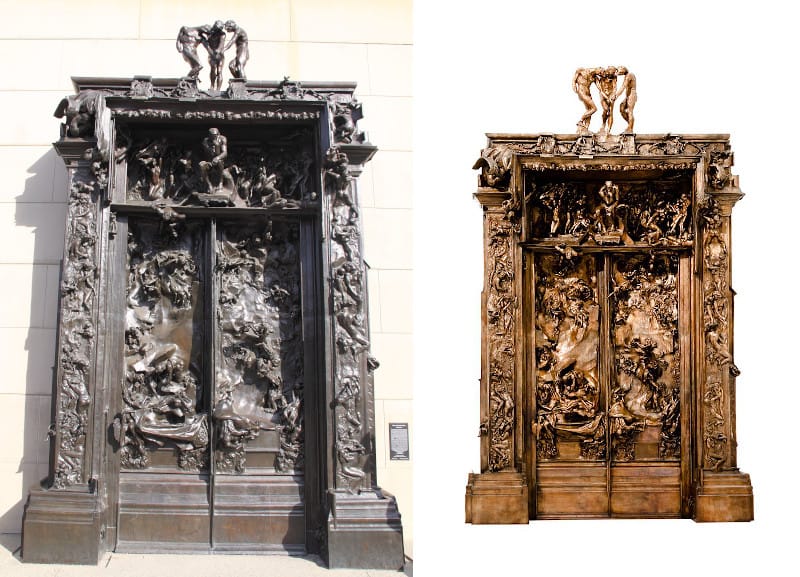The Gates of Hell - A Testament To Rodin's Boundless Creative Genius
The Divine Comedy, Dante Alighieri's remarkable narrative poem centered on the medieval vision of the afterlife, inspired a range of artists through the centuries, one of them being Auguste Rodin.
This prolific French artist, who is considered the progenitor of modern sculpture, reached fame at the fin de siècle for producing complex forms that abandoned traditional themes of allegory and mythology. His impressive oeuvre is characterized by a new, far more naturalistic approach to the representation of the human body.
Occupying a unique place in his oeuvre, Rodin's The Gates of Hell is a monumental sculptural group made of bronze that features a scene from the Inferno, the first section of Dante Alighieri's Divine Comedy.

The Work That Was in the Making for Decades
In 1880, the Directorate of Fine Arts commissioned the sculpture that should have been produced in 1885. However, Auguste Rodin continued working on and off on this project for more than three decades until his death in 1917. The Directorate searched for a design for the entrance to a planned Decorative Arts Museum, while the choice of theme was left to Rodin. Even before this commission, Rodin already created several sketches inspired by the Divine Comedy.
Although this particular museum was never built, the famed sculptor continued working on this project at the Hôtel Biron. In the last few years of his life, Rodin donated sculptures, drawings, and reproduction rights to the state. Two years after his death, the Hôtel Biron transformed into the Musée Rodin.
Six meters high, four meters wide and one meter deep, The Gates of Hell contains 180 figures ranging from 15 centimeters high up to more than one meter. For this project, the artist was contemplating the idea that this grandiose gate should literally evoke the experience of hell described by Dante in his Inferno.
Working on the piece for years, Rodin created over 200 figures and groups that formed a breeding ground for ideas that he drew on for the rest of his working life. Although he stopped working on the piece in 1890, he decided to finally unveil it in his first solo exhibition in Paris in 1900. However, the work was exhibited in segments, as the artist gave up on the idea of mounting the figures that he felt stood out the most as opposed to the background. It wasn't until 1917 that Léonce Bénédite, the Musée Rodin’s first curator managed to pursue Rodin to allow him to reconstruct the masterpiece in bronze. The artist died before seeing the piece finished.
While working on The Gates of Hell Rodin was profoundly inspired by high and low reliefs found on medieval cathedrals, but also the later achievements such as Lorenzo Ghiberti's Gates of Paradise 15th century bronze doors at the Baptistery of St. John, Florence, depicting figures from the Old Testament; Michelangelo's fresco The Last Judgment; and the works his contemporaries - Delacroix's painting The Barque of Dante, Balzac's collection La Comédie Humaine and Baudelaire's poems Les Fleurs du mal.

The Individual Works
Eventually, many of the sculptures Rodin made for The Gates of Hell became autonomous works of art cherished by many. The best-known one is definitely The Thinker (Le Penseur), also called The Poet. Originally located above the door panels, this sculpture is believed to represent either Dante observing the characters in the Inferno, Rodin himself meditating about his composition, or the Biblical figure of Adam, contemplating the destruction of mankind caused by his sin.
Another sculpture that gained enormous popularity is The Kiss (Le Baiser) which originally represented Paolo and Francesca, two characters from Divine Comedy. Rodin wanted to represent both initial joy and final damnation, however, he removed this sensual sculpture from The Gates of Hell because he felt it conflicted with the other suffering figures.
Another important sculpture is Ugolino and His Children (Ugolin et ses enfants) that features Ugolino della Gherardesca, the man who ate the bodies of his children after they died of starvation (Dante, Inferno, Canto XXXIII). In 1882, the Ugolino group was cast as a separate bronze.

The Legacy of Rodin's The Gates of Hell
The original plaster cast of the Gates of Hell is displayed at the Musée d'Orsay in Paris, while several plaster casts illustrating the development of the composition are displayed at the Musée Rodin in Meudon. In 1917, the original model was used to make three other bronze casts that are today held at the Musée Rodin, Paris, The Rodin Museum, Philadelphia, Pennsylvania, The National Museum of Western Art in Ueno Park, Tokyo. Subsequent bronzes are also to be found in several other institutions.
Rodin’s Gates of Hell exemplifies the innovative way this groundbreaking artist dealt with the composition based on the descriptions found in Alighieri's Divine Comedy. Moreover, this work comes as a climax of his creative vision which departed from the idealism of the Greeks, and the decorative beauty of the Baroque. As showcased by the figures and groups in this captivating formation, Rodin believed that an individual character was unraveled by his physical features. For stylistic and technical innovation of the given media, as well as a deeper understanding of the theme, the Gates of Hell is today widely perceived as one of the best works Auguste Rodin has ever made.
Featured image: The Thinker in The Gates of Hell at the Musée Rodin, Paris. Image Creative Commons.
Can We Help?
Have a question or a technical issue? Want to learn more about our services to art dealers? Let us know and you'll hear from us within the next 24 hours.
